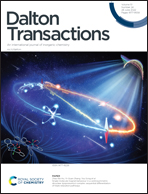Field-induced slow magnetic relaxation behaviours in binuclear cobalt(ii) metallocycles and exchange-coupled clusters†
Abstract
Precise control of the structures and magnetic properties of a molecular material constitutes an important challenge to realize tailor-made magnetic function. Herein, we report that the ligand-directed coordination self-assembly of a dianionic cobalt(II) mononuclear complex and selective organic linkers has led to two distinct dicobalt(II) complexes, [Co2(pdms)2(bpym)3]·2MeCN (1) and [Co(pdms)(bipm)]2·3DMF (2) (H2pdms = 1,2-bis(methanesulfonamide)benzene; bpym = 2,2′-bipyrimidine; bimp = 1,4-bis[(1H-imidazol-1-yl)methyl]benzene). Structural analyses revealed that complexes 1 and 2 are discrete binuclear molecules containing two neutral {Co(pdms)} species bridged by bpym and bimp ligands, respectively, forming an exchange-coupled CoII2 dimer and a rare CoII2 metallocycle. Magnetic studies found that 1 exhibits considerable antiferromagnetic interactions transferred by the bpym bridge while negligible magnetic interactions in 2 due to the long bimp ligands. Interestingly, both the complexes show significant magnetic anisotropy and thus exhibit slow magnetic relaxation under an external dc field originating from spin–lattice relaxation. Detailed theoretical calculations were further applied to understand the magnetic interactions and magnetic anisotropy in 1 and 2. The foregoing results highlight that coordination solids with programmed structures and magnetic properties can be designed and prepared through a judicious selection of molecular complex building blocks and organic linkers.



 Please wait while we load your content...
Please wait while we load your content...